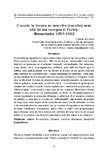Cuando la locura se inscribe (escribe) más allá de los cuerpos (I Parte): Nanacinder 1954-1962

Voir/
Date
2016-01Auteur
Palabras Clave
Escritura, Locura, Revista literaria, Hospital psiquiátricoWriting, Insanity, Literary magazine, Psychiatric hospital
Metadatos
Afficher la notice complèteRésumé
El hospital psiquiátrico se presenta como espacio de reclusión y cerco físico para el cuerpo del loco. Allí, la locura es “encerrada” para que deje de ser amenaza en el exterior “normal”, normalizado. Sin embargo, como todo cerco, el psiquiátrico contiene, más allá del límite que lo
define, una ambigüedad: esa en donde la locura ya no opera solo del lado unívoco de su binarismo —como antónimo de cordura— sino que, incluso dentro de esa misma relación (locura/cordura) se “respira” cierto aire de libertad. Si bien en el manicomio, el medicamento, la camisa de
fuerza química, el encierro, el electroshock... constituyen los principales medios de control —junto con la vigilancia—, dentro del manicomio, la
“laborterapia” se presenta como uno de los espacios libertarios desde donde el loco inscribe su enfermedad, es decir su otredad psíquica y social, mediante la creación literaria o artística. Ese espacio creativo en donde se inscribe y escribe la “enfermedad” representa un punto de fuga que tiene lugar en la creación de una revista editada, escrita
y distribuida por los pacientes de la Colonia Psiquiátrica de Bárbula
(Estado Carabobo, Venezuela), entre 1954 y 1962. Nos proponemos aquí realizar una lectura acerca del sentido de una revista en la que delirio y escritura constituyen una lógica que dio lugar a la creación.
Información Adicional
| Otros Títulos | When madness inscribes (writes) itself beyond the bodies (I): Nanacinder, 1954-1962 |
| Correo Electrónico | celiascanio@gmail.com |
| ISSN | 1315-8392 |
| Resumen en otro Idioma | The psychiatric hospital is presented as a place of imprisonment and physical siege for body of crazy. There, insanity is “locked” to stop being threatened on the outside “normal” standard. However, like everything fence, psychiatric contains, beyond the limit that defines an ambiguity: that in which madness no longer operates only the univocal beside her like binary opposite of sanity but even within that same relationship (madness / sanity) will “breathe” air of freedom. While in the asylum, the medicine, the chemical straitjacket, confinement... are the main means of control —with vigilance— together within the asylum, the “work therapy” is presented as one of libertarian spaces where the mad fits his illness, that is their psychological and social otherness, by literary and artistic creation. That creative space where you register and writes the “disease” represents a vanishing point which takes place in creating an edited magazine, written and distributed by the patients of the psychiatric colony Bárbula (Carabobo, Venezuela) between 1954 and 1962. We propose here a reading about the meaning of a magazine in which delirium and writing constitute a logic that led to the creation. |
| Colación | 71-80 |
| Periodicidad | Anual |
| País | Venezuela |
| Publicación Electrónica | Voz y Escritura. Revista de Estudios Literarios |
| Sección | Voz y Escritura. Revista de Estudios Literarios: Artículos |





